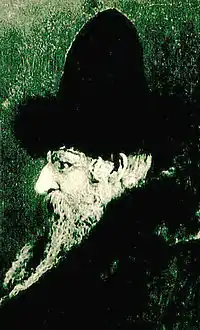Shtreimel
A shtreimel (Yiddish: שטרײַמל shtrayml, plural: שטרײַמלעך shtraymlekh or שטרײַמלען shtraymlen) is a fur hat worn by some Ashkenazi Jewish men, mainly members of Hasidic Judaism, on Shabbat and Jewish holidays and other festive occasions.[1] In Jerusalem, the shtreimel is also worn by Litvak Jews (non-Hasidim who belong to the original Ashkenazi community of Jerusalem, also known as Perushim). The shtreimel is generally worn after marriage, although it may be worn by boys after bar-mitzvah age in some communities.


History
There is speculation surrounding the origin of the shtreimel. Different theories hold that it is of Tatar, Turkish, Russian, or Polish[2] origin, but it is not possible to establish a clear chronology.[3] A common view is that the shtreimel was adapted by Jews living in Europe as a warm winter hat,[4] possibly inspired by nobility;[5][2][6][7] the shtreimel is comparable in construction to fur hats historically worn by nobles or gentiles across Europe and Russia.[7][8] According to the Jewish Historical Institute in Warsaw, the shtreimel could come from a period in the 17th century when Oriental costumes were considered fashionable by the nobility of the Polish–Lithuanian Commonwealth (Sarmatism).[8] One legend says that the initial reason for adopting the shtreimel was that the Jews were forced to wear an animal tail as a public humiliation.[4]
Types of shtreimels


Shtreimels worn by the Hasidim of Galicia, Romania, and Hungary, and Lithuanian Jews up until the 20th century were made of a large circular piece of black velvet surrounded by fur.
Hasidim originating from Congress Poland wear a high shtreimel (often called a spodik). The shtreimel of the Rebbes of the Ruzhin and Skolye dynasties is pointed upward.[9]
Symbolism
While there is strong religious custom for Jewish males to cover their heads, from the standpoint of Jewish law there is no religious significance to the use of the shtreimel as the head covering. However, the wearing of two head coverings (the shtreimel is always worn over a yarmulke) is considered to add additional spiritual merit, plus the presence of beautiful craftsmanship adds beautification and honour to the custom. Such headgear is worn on special occasions (such as Shabbat), in the synagogue, or by office-holders such as rabbis.
According to Rabbi Aaron Wertheim, Rabbi Pinchas of Koretz (1726–1791) stated that "[t]he acronym for Shabbos is: Shtreimel Bimkom Tefillin - the shtreimel takes the place of tefillin."[10] Since wearing special clothing on Shabbat is a form of sanctification, among the Hasidim of Galicia and Hungary the shtreimel is associated with the holiness of Shabbat, a crown such as that worn by royalty, which enhances and beautifies Shabbat.
Arnon asserts that the number of furs used in the manufacture of the shtreimel has some significance. Common numbers are 13, 18, and 26, corresponding respectively to the Thirteen Attributes of Mercy, the numerical value (gematria) of the word for life (Hebrew: חי), and the numerical value of the Tetragrammaton.[11] Contemporary shtreimlach may include higher numbers of tails. At least one maker creates shtreimelach with 42 tails, symbolizing the 42-letter Divine Name.
Male Orthodox Jews can be highly conservative regarding headgear, and some traditional Jews still wear fedoras or homburgs.[12] Although the traditional Jewish headgear is of Gentile origin and has specific historical and geographical roots, it continues to be worn by traditional Jews even when non-Jews in the country of origin have long stopped wearing it.
Manufacture
The shtreimel is typically custom-made from the tails of Canadian or Russian sable, beech marten, baum marten (European pine marten), or gray fox. The shtreimel is almost always the most costly article of Hasidic clothing.[13] Usually the bride's father purchases the shtreimel for the groom upon his wedding. Nowadays, it is customary in the United States to purchase two shtreimels: a cheaper version, called the regen shtreimel ("rain shtreimel"), is for occasions when the expensive one may get damaged. In Israel, due to the economic circumstances of most members of the Hasidic community in that country, the vast majority of shtreimel-wearers own only one shtreimel. The shtreimel manufacturers (shtreimel machers) keep their trade a closely guarded secret.[14]
References
Citations
- Blumenthal, Ralph (2009-05-10). "When He Talks Hats, Basic Black is Only the Beginning". New York Times. ISSN 0362-4331. Archived from the original on 2017-08-02. Retrieved 2009-05-11.
- "Hassidic Shtreimel". www.europeana.eu. Archived from the original on 2021-07-28. Retrieved 2021-07-28.
- Danna Lorch (17 May 2018). "Shtreimel Styles Are Ruled By Trends As Much As Tradition — Even For Hasidim". The Forward Association, Inc. Archived from the original on 9 December 2019. Retrieved 9 December 2019.
- "Of 'spodiks' and 'shtreimels'". The Jerusalem Post. Archived from the original on 2020-12-02. Retrieved 2021-02-03.
- Berel Wein: Living Jewish: Values, Practices and Traditions, p. 111; pp. 247–248. Mesorah Publications, 2002.
- "Jewish Clothing". My Jewish Learning. Archived from the original on 2021-01-18. Retrieved 2021-02-03.
- "Shtreimels and Spodiks". njop.org. Archived from the original on 2021-02-10. Retrieved 2021-02-04.
- "DELET". Archived from the original on 2020-08-05. Retrieved 2019-03-11.
- "Jewish Concepts: Shtreimel". Jewish Virtual Library. Retrieved October 20, 2023.
- Halachos V'halichos B'chasidus, p. 196
- Arnon, p.88
- "Orthodox Jewish black hat". 9 April 2019. Archived from the original on 17 June 2019. Retrieved 17 June 2019.
- Feldmar, Jamie (2011-09-20). "Williamsburg Hooligan Hoists Holy Hasidic Hat!". Archived from the original on 2019-03-22. Retrieved 2019-03-22.
- Arnon p.208
External links
 Media related to Shtreimels at Wikimedia Commons
Media related to Shtreimels at Wikimedia Commons